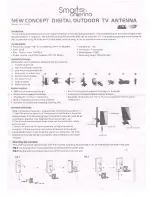
OM45T_
Rev N
Page 18
4.2 Inspections
The frequency of inspection is contingent upon the user’s individual standards and the operational environment
in which the earth station antenna is located. However, a visual inspection of the components should be
performed at least semi-annually. Where there are no established wear limits, perform a visual inspection to
locate worn or damaged parts that could result in a malfunction of the earth station antenna. It is recommended
that the mechanical and electrical inspections be performed on the assembled or partially disassembled
equipment to determine the extent of disassembly required prior to completely disassembling a component or
module that is suspected of malfunctioning. In the absence of any special inspection requirements, operational
tests are the most effective means in isolating parts and assemblies requiring further inspection. During
inspection, any noted damage and/or problematic condition which could preclude the continuation of proper
operation (prior to the next scheduled inspection) should be recorded. These discrepancies should be
immediately corrected (either by repair or replacement, as required), or dealt with immediately after the
inspection procedure has been completed.
CAUTION:
Allowing your antenna to continue to operate after damage or discrepancies have been noted during
inspection may result in property damage (especially to your earth station antenna), as well as increase the risk of
creating dangerous situations for personnel, causing personal injury and/or loss of life.
-
-
-
-
-
-
-
-
-
-
-
-
-
-
4.2.1 Local Control/Motor Drive Controller Inspection
Inspection of the Local Control/Motor Drive Controller generally conforms to standard visual inspection
procedures for electromechanical equipment. In addition to such standard procedures, you will need to
perform the following checks and visual inspections for the specific conditions as noted:
•
Check the front panel for illegible signage and/or indistinct panel markings
•
Check the three (3) position selector switches (Azimuth-Slow/Fast, Elevation-Slow/fast, and Polarization-
CCW/CW) for smooth operation. Note that there is an audible click during actuation (from Left to Center)
for each switch. Note that there is a spring return (from Right to Center). For each of the two Position
Selector Switches (Azimuth-East/West, Elevation-Up/Down, and Local/Remote), individually inspect both
for smooth operation and audible clicks for each actuation
•
Inspect all wiring and cables for discoloration, burned insulation, dirt, breaks, secure connections, and
other signs of damage or deterioration. Examine connections for dirt, flux, corrosion, and mechanical
defects. Check for loose or broken lacing, as well as cuts, cracking, dry rot, braiding, or frays
•
Inspect all connectors for corrosion, broken inserts, and stripped threads. Inspect connector shells,
checking for distortion and dents. Inspect contact pins for bends, misalignment, and/or other deformities.
Check connector inserts for carbon tracking, burns, or charring, indicating arc-over
•
Check all electrical components for dirt, cracks, chips, breaks, discoloration, and any other signs of
damage or deterioration. Discoloration, blistering, or burns are evidence of overload(s). Measure the
actual value(s) of any suspect electrical components (as with a digital multimeter) and compare against
value(s) in the product’s specifications
•
Inspect transformer for excessive wax deposits on the surface. Visually inspect for discoloration. Smell
the air around it to check for pungent odors (scents of ozone or burning), which is evidence of
overheating. Overheating may be a precursor to a total breakdown
•
Inspect all terminal boards for broken or missing terminals and/or stripped threads. Check the tightness of
lead-attaching hardware
•
Inspect each starter for a make-after-break provision, by releasing one pushbutton as the alternate
pushbutton is being simultaneously pressed
•
Inspect the relays and contactors for free operation of the armatures and contact condition. The contacts
may still be usable even though pitted, burned, worn, or discolored. Contacts, contactors, or relay
assembly should only be replaced when the contact material has been completely torn away or worn off











































